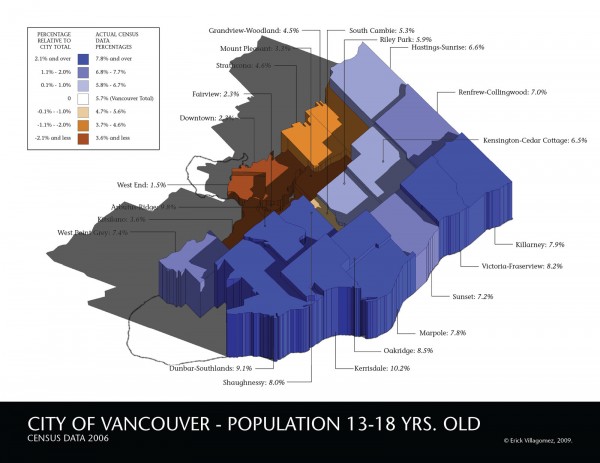
Finally, we turn our gaze to spatial distribution of the last group in our cartographic series of children in Vancouver: teenagers from thirteen to eighteen years of age.
Like last time, those newcomers interested in a more in-depth explanation how the graphics were structured and represented, should refer to one of my first two posts of the series – here and/or here.
To the map….at first glance we see an overall pattern similar to that in the last age category: with the distribution of above average neighbourhoods being relatively equal on the east- and westside, and the communities immediately around False Creek at the bottom of the pack.
The similarity is only skin deep, however, given that we are seeing the emerging dominance of the more expensive westside neighbourhoods as having the highest percentage of people in this age category. With the exception of Dunbar Southlands, that has remained at the top in all categories to-date, most of the neighbourhoods are new to upper ranks.
Once again, I believe there is a relationship between what we are seeing and the era in which these children were born. Our graph above showing average home prices over the past three decades, depicts at time (between 1993-1988) during which homes were almost at their lowest. Certainly, this gave families with children many more neighbourhood options when choosing a location to live and, naturally, many people gravitate towards the areas with the largest lot sizes.
Another interesting phenomenon we see here is the decline of South Cambie below the city average. Given that the percentage of children in the area has remained consistently high in the in other age categories, it’s curious that the oldest group – and seemingly least demanding to house spatially given their independence – would place it among the lower communities. Furthermore, in terms of statistics, the neighbourhood is similar to several of its above average neighbours. Your guess is as good as mine.
In order to bypass any repetition – particularly about the characteristics of the neighbourhoods at the bottom of the spectrum – I’m going to leave it at that for now. The next, and final, piece is going to look at the maps as a group and attempt to highlight larger patterns that are visible when they are seen in conjunction with one another….
***
Other Where Are The Kids? series articles:
Children under Three Years Old
Children Three to Five
Children Six to Twelve



